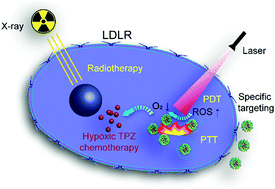当前位置:
X-MOL 学术
›
J. Mater. Chem. B
›
论文详情
Our official English website, www.x-mol.net, welcomes your feedback! (Note: you will need to create a separate account there.)
Anti-LDLR modified TPZ@Ce6-PEG complexes for tumor hypoxia-targeting chemo-/radio-/photodynamic/photothermal therapy.
Journal of Materials Chemistry B ( IF 7 ) Pub Date : 2020-01-03 , DOI: 10.1039/c9tb02248a Chuanhui Song 1 , Wenguang Xu 1 , Zheng Wei 2 , Changjin Ou 3 , Jinhui Wu 4 , Jinlong Tong 5 , Yu Cai 6 , Xiaochen Dong 3 , Wei Han 7
Journal of Materials Chemistry B ( IF 7 ) Pub Date : 2020-01-03 , DOI: 10.1039/c9tb02248a Chuanhui Song 1 , Wenguang Xu 1 , Zheng Wei 2 , Changjin Ou 3 , Jinhui Wu 4 , Jinlong Tong 5 , Yu Cai 6 , Xiaochen Dong 3 , Wei Han 7
Affiliation

|
Hypoxia, a state of low oxygen tension in solid tumors, is not only closely correlated with resistance to both radiotherapy and chemotherapy, but also associated with poor prognosis of tumors and regional lymph node status. Herein, based on the analysis of cell samples from tumor patients, low-density lipoprotein receptor (LDLR) was found to be overexpressed on the surface of hypoxic tumor cell membranes, and confirmed to be an effective hypoxia marker through specific binding with anti-LDLR antibody in solid tumors. In addition, using the special therapeutic microenvironment of hypoxia, tirapazamine (TPZ, which can be used as both a hypoxia-activated chemotherapy prodrug and radiotherapy sensitizer) was integrated with PEGylated photosensitizer chlorin e6 (Ce6-PEG) by self-assembly, and anti-LDLR was then modified on the surface to form tumor hypoxia-targeting multifunctional nanoparticles (CPTA). CPTA possesses a multimodal antitumor effect via a simultaneous photothermal therapy (PTT)/photodynamic therapy (PDT) effect generated by Ce6, and chemotherapy/radiotherapy actions sensitized by TPZ. It is noteworthy that tumor oxygen was consumed in the process of PDT and the hypoxia was subsequently exacerbated, which can greatly increase the TPZ-sensitized chemotherapy and lead to a synergistic antitumor effect. Both in vitro and in vivo experiments demonstrated that CPTA possesses an excellent therapeutic effect through PTT, PDT, and TPZ sensitized radiotherapy and chemotherapy. This hypoxic tumor targeting synergetic therapeutic strategy has great potential for future clinical transformation.
中文翻译:

抗LDLR修饰的TPZ @ Ce6-PEG复合物,用于靶向肿瘤缺氧的化学/放射/光动力/光热疗法。
缺氧是实体瘤中低氧张力的状态,不仅与对放疗和化疗的耐药性密切相关,而且与肿瘤的预后不良和区域淋巴结状态密切相关。在此,基于对来自肿瘤患者的细胞样品的分析,发现低密度脂蛋白受体(LDLR)在低氧肿瘤细胞膜表面上过表达,并且通过与抗LDLR特异性结合而被证实是有效的缺氧标记物。实体瘤中的抗体。此外,利用低氧的特殊治疗微环境,通过自组装将替拉帕明(TPZ,既可以用作低氧激活的化疗前药,也可以用作放射治疗敏化剂)与PEG化光敏剂二氢卟酚e6(Ce6-PEG)整合在一起,然后在表面修饰抗LDLR,形成靶向肿瘤缺氧的多功能纳米粒子(CPTA)。CPTA通过Ce6产生的同时光热疗法(PTT)/光动力疗法(PDT)效应和TPZ敏化的化学疗法/放射疗法作用,具有多峰抗肿瘤作用。值得注意的是,PDT过程中消耗了肿瘤氧,随后缺氧加剧了,这可以大大增加TPZ敏感的化学疗法并产生协同的抗肿瘤作用。体外和体内实验均表明,CPTA通过PTT,PDT和TPZ敏化放疗和化疗具有出色的治疗作用。这种针对缺氧肿瘤的协同治疗策略具有巨大的潜力,可用于未来的临床转化。
更新日期:2020-02-10
中文翻译:

抗LDLR修饰的TPZ @ Ce6-PEG复合物,用于靶向肿瘤缺氧的化学/放射/光动力/光热疗法。
缺氧是实体瘤中低氧张力的状态,不仅与对放疗和化疗的耐药性密切相关,而且与肿瘤的预后不良和区域淋巴结状态密切相关。在此,基于对来自肿瘤患者的细胞样品的分析,发现低密度脂蛋白受体(LDLR)在低氧肿瘤细胞膜表面上过表达,并且通过与抗LDLR特异性结合而被证实是有效的缺氧标记物。实体瘤中的抗体。此外,利用低氧的特殊治疗微环境,通过自组装将替拉帕明(TPZ,既可以用作低氧激活的化疗前药,也可以用作放射治疗敏化剂)与PEG化光敏剂二氢卟酚e6(Ce6-PEG)整合在一起,然后在表面修饰抗LDLR,形成靶向肿瘤缺氧的多功能纳米粒子(CPTA)。CPTA通过Ce6产生的同时光热疗法(PTT)/光动力疗法(PDT)效应和TPZ敏化的化学疗法/放射疗法作用,具有多峰抗肿瘤作用。值得注意的是,PDT过程中消耗了肿瘤氧,随后缺氧加剧了,这可以大大增加TPZ敏感的化学疗法并产生协同的抗肿瘤作用。体外和体内实验均表明,CPTA通过PTT,PDT和TPZ敏化放疗和化疗具有出色的治疗作用。这种针对缺氧肿瘤的协同治疗策略具有巨大的潜力,可用于未来的临床转化。


























 京公网安备 11010802027423号
京公网安备 11010802027423号